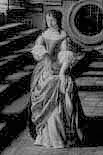Lady Anne Conway, about 1660, a detail from the domestic portrait by Samuel van Hoogstraaten
When
I was writing my most recent book I encountered a fine example of this happy
phenomenon relating to Valentine Greatrakes, the “Stroker”, a faith healer who
baffled some of the great minds of the early Enlightenment in England. It was then that there came into my
hands a big octavo entitled Conway
Letters: the Correspondence of Anne, Vicountess Conway, Henry More, and Their
Friends, 1642-1684, edited by Marjorie Hope Nicolson (New Haven, 1930).*
Anne
Finch, the daughter of Sir Heneage Finch, who for a time in the reign of
Charles I was the Speaker of the House of Commons, was born in 1631. At the age of twenty she married Edward
Conway, later Earl of Conway, the heir to an imposing country house, Ragley, in
Warwickshire. From the
intellectual point of view Lord and Lady Conway were one of the premier power
couples of her age, or any other I suspect. Lord Conway amassed at Ragley an imposing scholarly
library. It was still a time when
a voracious scholar could hope to be familiar with almost every important book
issuing from the press, and his book agents scoured the bookshops of the
Continent for new works in every field of learning.
Yet
in this close and loving marriage the distaff was mightier than the spade. At a time when women were subordinated
in all walks of life, excluded from the universities and the professions,
disabled by custom and by law, Anne Conway has to be reckoned one of the great
intellectuals of her day. Latin,
Greek, and Hebrew she mastered at a high level. Wholly on the basis of recognized ability she was accepted
as a private pupil by Henry More , the Cambridge Platonist, who judged her the
ablest interpreter of the philosophy of Descartes he had ever met. More and other famous scholars and
philosophers like Ralph Cudworth made of the Ragley dining room a kind of
running salon of virtuosity.
Many
of the familiar letters that passed among this elite group were used by their
less impressive posterity to kindle fires or polish furniture! By extraordinary good fortune, however,
a substantial number were preserved
in a great wooden chest, eventually falling into the rescuing hands of Horace
Walpole, a man who knew a thing or two about letter-writing and the value of
letters.
Only
in the twentieth century, however, did they get their due when Marjorie Hope
Nicolson took them up as a scholarly project. In Professor Nicolson Lady Anne Conway found her match, or
at least her modern analogue.
Nicolson (1894-1981) was a brilliant scholar of seventeenth- and
eighteenth-century English literature who, like Conway, was a bold pioneer in
what in the upper echelons of American higher education was still pretty much a
man’s world. Her list of
“first woman to…” is impressive.
She was the first woman to take a doctoral degree in literature at
Yale—which she did in two years--the first woman to teach on the graduate
faculty of an Ivy League institution (Columbia), the first woman President of
Phi Beta Kappa, the first woman president of the Modern Language Association. She declined the invitation to become
the first woman president of Smith, where she had served as a distinguished
professor and dean.
Her
scholarship, too, was pioneering, and revolutionary. She had a rigorous philosophical mind and a deep knowledge
of the history of science. She was
thus perfectly prepared to undertake investigations of the extraordinary impact
on the literary imagination of the scientific explosion of the seventeenth
century and the later Enlightenment.
There are not a great many books that I myself remember vividly from
graduate school in the early sixties, but two of them were by Nicolson: Newton Demands the Muse: Newton’s Opticks and the Eighteenth Century
Poets and Science and Imagination. I met her once, in 1961. She gave a lecture at Princeton, an institution
at which there was not then a single woman student or faculty member. Yet I remember that one of my heroes, the genial Louis Landa, no
slouch of a scholar himself, introduced her as the greatest of living American
literary scholars.
The
Conway Letters naturally have of themselves
the fascination of bringing to life the rather amazing life and thought of a
unique community of English aristocratic and philosophical thinkers three
centuries and more ago. But their
organization, edition, and introduction by a modern scholar who lived and
breathed the seventeenth century and who wrote with the sparkle of a wizard and
the clarity of an angel makes of them something of a modern masterpiece as
well. I think Lady Anne would be
most pleased.
*Oxford
brought out a renewed edition in 1992.

